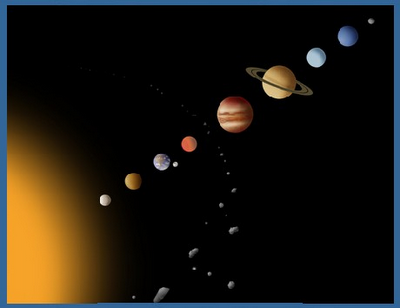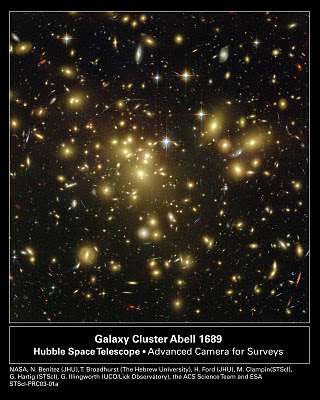I remembered some things I learned in my astronomy class in high school. (Humor me on this little scientific diversion..)

This picture has squished all the planets together in one frame and distorted all the sizes of the planets and the sun. The big planets are much bigger and all the distances are much more far apart. (If you want to teach your kids about the real distances and sizes of the planets, here is a link to instructions for a “planet walk” you can do to help bring the proper scale into perspective.)
Consider each of these things carefully..
The earth is about 8,000 miles across.
Light travels about 186,000 miles per second.
(If the earth were completely hollow and two mirrors were placed opposite each other at the equator, light could bounce between them 23 times in a single second.)
The earth is about 93 MILLION miles from the sun.
It is so far away that it takes light 8 minutes to get from the sun to the earth.
Pluto’s average distance from the sun is about 40 times greater than the earth’s. It is about 5.3 light-hours away from the sun.
The closest star to us is Proxima Centari, a red dwarf star 4.2 light-years away.
Now let's jump to the galaxy level.

The sun is about 2/3rds of the way out from the middle of the Milky Way galaxy, or about 25,000 light years away from the center (1).
The Milky Way galaxy is an estimated 100,000 light years across (2). Our solar system is so small in comparison that the smallest dot in its approximate location on the map would exaggerate its size by 100 times.
Astronomers estimate our galaxy may have between 200 to 300 BILLION stars in it (3).
Now.. check out this next picture..

Look at all those galaxies… *
I remember when I saw a picture very similar to this in my astronomy class, it made my brain explode inside my skull. HEAVENLY FATHER CREATED ALL OF THAT AND MORE! It is a testimony to the glory, majesty, and power of God. This awes me to no end. That awe leads to a deep sense of reverence for God.
Mind-blowing Concept #2
There’s something else that brings me to a feeling of deep awe and reverence. When I think of all the mistakes I have made and the sins I have committed and the pain I have experienced in my life, it is amazing to me that Jesus Christ suffered for all of it too. But then when I remember He also suffered those things for my family…
and for my ward…
and for all the people of our church…
and for all the people living on earth right now…
and for all the people who have ever lived or who will yet live on earth….
That causes my brain to explode again inside my skull.
Mind-blowing Concept #3
Heavenly Father hears my prayers and He answers them. He understands my language. He also hears and answers prayers in every other language, even when the prayers are being said simultaneously. The idea that He can make sense of, let alone respond to such a staggering array of messages, languages, pleas, thanks, praise, and more causes my brain to explode again inside my skull.
All of this brings me to a feeling of great reverence for God. With an awareness of Heavenly Father’s powers of creation, we can trust His purposes for us. With an awareness of Jesus’s magnificent demonstration of love in the atonement, we can obey the commandment to repent. With an awareness of Heavenly Father’s ability to hear and understand so many different messages directed to Him, we gain the ability to trust His responsiveness.
Awe for God leads to reverence.
Reverence toward God leads to love and trust.
Love and trust in God leads to obedience.
* There are many galaxies in this picture, and some of them have so much gravitational energy that they actually bend the light of other galaxies, producing multiple images of them. Google "gravitational lens."
Sources
1 Gene Smith Astronomy Tutorial, “The Milky Way Galaxy”, http://casswww.ucsd.edu/archive/public/tutorial/MW.html
2 “Milky Way Galaxy”, Space Yuga, Feb. 6, 2011, http://spaceyuga.com/milky-way-galaxy/
3 Nicholos Wethington, December 16, 2008, “How Many Stars are in the Milky Way?”, http://www.universetoday.com/22380/how-many-stars-are-in-the-milky-way/
Images
Milky Way Galaxy Image from http://spaceyuga.com/milky-way-galaxy/,
Galaxy Cluster Image from Starts with a Bang, http://scienceblogs.com/startswithabang/2010/11/hey_dark_matter_where_are_you.php
Solar system Image from Purple Slinky, http://purpleslinky.com/trivia/science/amazing-things-about-our-solar-system/
Continue reading at the original source →



